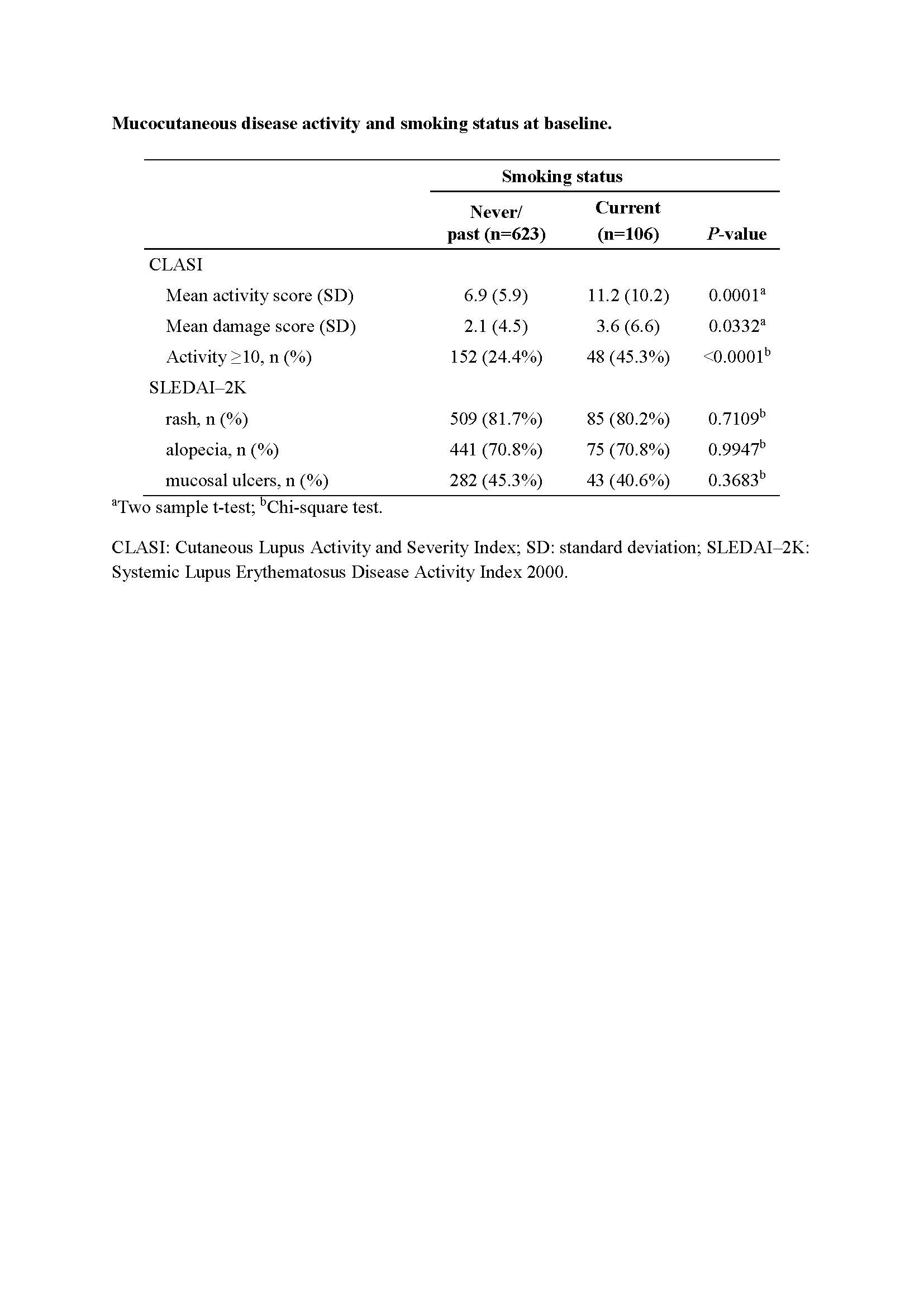Session Information
Session Type: ACR Poster Session C
Session Time: 9:00AM-11:00AM
Background/Purpose: Studies have demonstrated an association between smoking and more severe cutaneous lupus erythematosus, resulting in decreased health-related quality of life and treatment response.1 We analyzed the influence of smoking on cutaneous manifestation severity post hoc in adults with moderate to severe SLE who enrolled in either of two Phase IIb randomized, placebo-controlled studies of anifrolumab or sifalimumab.
Methods: Baseline mucocutaneous disease activity in current smokers (stopped for <1 year) and never/past smokers (stopped for >1 year) enrolled in randomized placebo-controlled studies of anifrolumab (NCT01438489; MUSE)2 or sifalimumab (NCT01283139)3 was evaluated by the Cutaneous Lupus Erythematosus Disease Area and Severity Index (CLASI) and SLE Disease Activity Index 2000 (SLEDAI–2K) mucocutaneous descriptors. Disease activity was compared between smoking status-defined subgroups. Smoking status was collected as part of the baseline cardiovascular risk assessment.
Results: A total of 736 patients were randomized in both studies. Patients were mostly female (92.8%), with a median age of 39 years and median disease duration of 5.9 years. Baseline CLASI and SLEDAI–2K scores, and smoking status, were available for 729 patients. At baseline, 81.5%, 70.8%, and 44.6% of patients had SLEDAI–2K-defined rash, alopecia, or mucosal ulcers, respectively. Current smokers had significantly greater CLASI activity and damage scores, compared with never/past smokers (table). Where group numbers were large enough to make sufficient evaluations, CLASI activity scores were consistently greater in current smokers irrespective of race, ethnicity, or SLE medication. There was no significant difference in CLASI activity scores between never and past smokers (6.9±5.8, 7.5±6.3, respectively; p=0.4857). A significantly greater percentage of current smokers had a moderate or severe rash, defined by CLASI ≥10 (p<0.0001).
Conclusion: Cutaneous disease activity was consistently greater in current smokers compared with never/past smokers, irrespective of race, ethnicity, or SLE medication; this suggests that smoking may actively worsen skin disease. CLASI appears to be a more sensitive measure of inflammatory skin involvement than the SLEDAI–2K mucocutaneous descriptors. As CLASI activity was similar in never/past smokers, smoking cessation should be encouraged in SLE inflammatory skin management.
References:
1. Piette EW, et al. Arch Dermatol 2012;148:317–22.
2. Furie R, et al. Arthritis Rheumatol 2017;69:376−86.
3. Khamashta M, et al. Ann Rheum Dis 2016;75:1909−16.
To cite this abstract in AMA style:
Werth VP, Illei G, Abreu G, Wang L, Greth W. Association of Smoking and Cutaneous Manifestations in Systemic Lupus Erythematosus (SLE): Post-Hoc Results from Phase IIb Studies of Anifrolumab and Sifalimumab [abstract]. Arthritis Rheumatol. 2017; 69 (suppl 10). https://acrabstracts.org/abstract/association-of-smoking-and-cutaneous-manifestations-in-systemic-lupus-erythematosus-sle-post-hoc-results-from-phase-iib-studies-of-anifrolumab-and-sifalimumab/. Accessed .« Back to 2017 ACR/ARHP Annual Meeting
ACR Meeting Abstracts - https://acrabstracts.org/abstract/association-of-smoking-and-cutaneous-manifestations-in-systemic-lupus-erythematosus-sle-post-hoc-results-from-phase-iib-studies-of-anifrolumab-and-sifalimumab/

